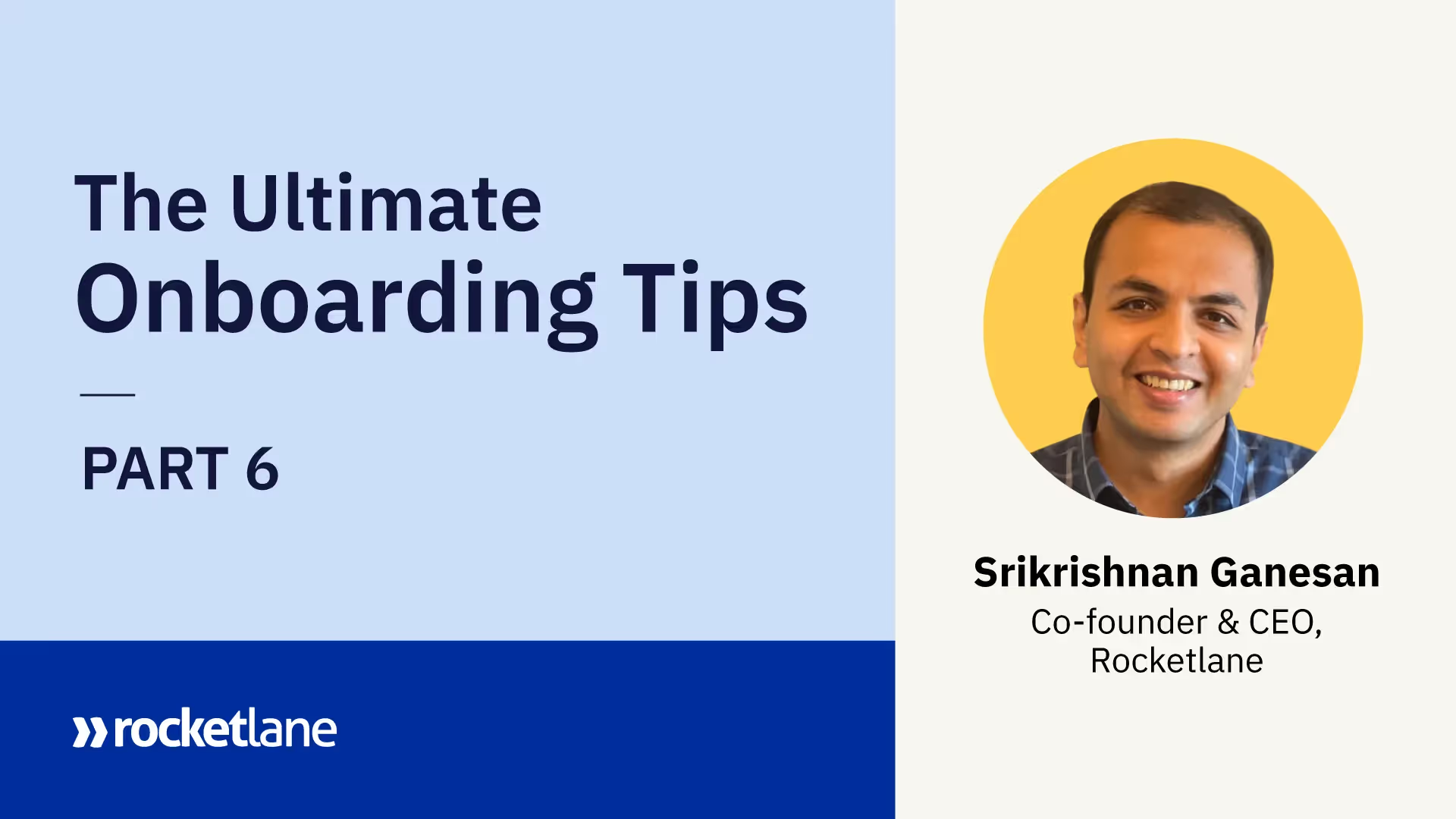Welcome to Part VI of the Customer Onboarding Tips blog series. In part V, we looked at the importance of training videos, readiness kits, and engineering great first impressions.
In this installment, we’ll learn more about showing flexibility in your implementation plans, customer effort levels, and the importance of having quarterly reflection meetings.
As always, grab a cup of your favorite beverage so we can get started!
Tip #26: Show flexibility in your speed
Customers like their vendors to show some flexibility in their delivery. Customers also expect their vendors to know what they are doing, and the onboarding manager or CSM they are working with to be a seasoned expert.
This tip aims to tap into both elements to impress a new customer quickly and get the right initial handshake with the customer - to hold each other accountable for an on-time onboarding.
If your customer has a specific go-live date constraint or wants to do things faster, you should be able to accommodate their requirements as long as they promise to work with you with the same intensity.
Here's our recommended approach:
- At the kickoff or even pre-sale stage, showcase your standard onboarding process. Let's say you plan a 5-6 week journey for them. Show your customer/prospect the methodology and the project plan with the key milestones and dates mentioned. It is a powerful signal to the customer about your maturity if you have a well-defined onboarding plan (as opposed to sharing a spreadsheet with a few tasks on it).
- Tell them this is your standard plan, but you can move things around a little or compress the journey if they have tight deadlines or availability constraints.
- You could move phases/milestones around to pull back the overall go-live time or a specific milestone. Typically, this may be more about going live before a specific date, which need not have all integrations, data migrations, etc., completed before that - you just need the key ones. The rest can be pushed for later on in the plan. Discuss and understand things from your customer's side as you craft the new plan.
- Once you have their inputs, it'd be great if you have some quick changes in your mind that you can implement right on the call. Show them an updated plan in the same meeting (or just after) to get their agreement on the process. Get all key stakeholders to agree, and call out any risks you foresee.
- Once they confirm, freeze your plan and hold everyone to the timeline!
The more you do this, the more you will know where you want to show flexibility, what you want to bring things ahead, what you want to keep for the next iteration, etc.
Tip #27: The Challenge
Many of the tips we've shared so far have focused on the intensity and accountability aspects of a customer onboarding project. This time we'll explore an idea to keep up your implementation momentum and make it an exciting challenge.
The idea is simple: At kick-off, share the median and top 20 percentile time to complete your onboarding journeys, and ask your customers if they are up for a challenge! If they complete onboarding successfully and are in your top 20 percentile, they have conquered the challenge and have made it to your "Implementation Hall of Fame".
Some customers may opt-out of this for good reasons, which is perfectly fine, but the challenge is still worth trying out!
If enterprise customers say they don't want to hurry an implementation, that's fine, but they should still want to do better than your median time!
Remember, everything you measure and benchmark comes in handy for the executive on the customer side to challenge their team too!
Note: It may make sense to propose the challenge only based on the readiness level of the customer. Pushing a customer who's at level 0 to get to level 3 in quick time may result in a bad experience for everyone.
Tip #28: Quarterly Reflection Meetings
It helps to have a quarterly ritual to get your onboarding team together, review your metrics as a team, and come prepared with an analysis to determine key initiatives you want to drive for the next quarter. Call this the Quarterly Reflections Meeting.
Every team member is in charge of coming up with their list of top issues in onboarding and their top ideas to positively impact the onboarding experience for the customer and team productivity.
Make sure you carry data to the table from team members and systems to help quantify the ideas' impact and measure the initiatives' success. Here are some key metrics and questions to consider during your reflections meeting:
- Feedback from the team on critical areas, phases, or onboarding tasks that are problematic
- Effort/time taken for various tasks from the time tracking reports
- Tasks, milestones, and phases that are most often delayed or finished on time
- Analysis of new initiatives that were championed in the last quarter and their impact
- Average, median, and 90th percentile of time-to-first-value across the onboardings in the quarter
- CSAT and free-form text feedback/inputs from teams onboarded in the quarter
Use the meeting to first discuss and agree upon key problem areas, identify and plot initiatives on an "impact vs. effort" graph to ensure you pick high-impact ideas first. Finalize new initiatives that your team members want to champion in the upcoming quarter, and determine metrics that will help determine the success or failure of the new initiatives.
Tip #29: The Customer Effort Score
If you have a mature product, onboarding can be challenging, especially because the customer may not have the maturity needed to use your product, and you may be trying to set them up for too much too early.
While the customer may enjoy the benefits of a fully set up product, they may lose hope along the implementation journey if it feels like too much effort from their end or a lot of learning and work before they start seeing any value. This is when they start ghosting you and tell their bosses or colleagues that your product setup demands too much of their time and they aren't able to get their other work done.
If you hear that the customer "got busy with other priorities," one of your takeaways should be that they couldn't multi-task and take your implementation to completion because it was too much effort.
Why is a high-effort implementation bad?
- Churn: Customers may ghost you during implementation and churn
- Defensive CSM, slow growth: Delayed implementations lead to your team being on the backfoot with the customer, slower ROI, and lower confidence in engaging more with you.
- Limited expansion opportunities: Even if they get through it, they negatively perceive your offering and dread engaging in such an exercise like this again. So they may not want to grow their use cases or engagement with your product.
- Lower NPS: If you have a low friction implementation that feels like a breeze to the customer, they will talk about it to their industry peers. You just missed a great way to get great word of mouth!
How do you get better at this? Measure your Customer Effort Score!
Start measuring what the customer feels the level of effort is for the onboarding, and try to understand which stages or steps they feel are the highest effort from their end.
Send out a survey to all customers going through the implementation journey with you - to collect how customers score you 1 to 10 on how complex your implementation was for them, and then information on what specific phases or tasks were hardest to get past.
This way, you can figure out how to make those steps easier, such as:
- Break them down into smaller pieces they can handle
- Offer a more prescriptive approach
- Provide help or educational content for those steps
- Offer consulting services to bridge maturity gaps
- Bring in partners for some parts of the implementation
- Make it a phased implementation
Every month you can reflect on the effort scores from your customers and identify key tasks, phases, or milestones that need a revamp to make it easy for the customer.
So try this out and share your learning with us at care@rocketlane.com
Tip #30: Plan for the buyer, user, and end-user engagement
Remember that there are multiple types of stakeholders in any mid-market or enterprise sale. For example, for our product, Rocketlane, which is into accelerating customer onboarding and implementation projects:
- The buyer with the budget may be a CCO, a VP of CS, or a VP of PS
- The user may be a Head of PS, Head of Onboarding/Implementation, or a lead in CS
- Another key influencer may be from CS Ops or Services Ops
- End-users are your onboarding specialists, engagement managers, or CSMs
While we all know that we need to do admin and user training, we often don't formulate our onboarding plans considering the engagement needed for each persona during the journey.
Here are some ideas of what is needed for each:
- Buyers need conversations and updates around their top goals, priorities, and ROI. The steering committee meetings and ROI workshops discussed in previous tips are great ways to engage them.
- The functional leader/user persona needs to see how you are helping meet goals, ROI, and updates on hitting key milestones on the journey. They will also want to be very plugged in on adoption, reports, dashboards, and anything you can do for their team to learn/grow. Communicate with them about timelines and milestones, keep them actively involved while setting up reports and dashboards, and share your adoption plans and any sessions you do for their team to engage and level up (like an expert session to activate and energize the group). Also, maybe have a session to talk to other customers who can share how they are getting value to put them in a frame of mind to pursue extracting similar value for their team. Involve them in finding the right initial end-users from their team who can be internal champions for adoption
- The ops lead needs admin training and active help in setting up the account, setting up the reports, etc. Help them with best practices sessions, and work on iterating your plan with these folks to ensure they are partners with you throughout the journey.
- For end-users, plan sessions to (1) energize, (2) train, (3) activate (per go-live plan), and (4) support them through the journey. You must ensure they come in with the right mindset, knowing what they are getting out of this and why it is important for the company. We've written in the past about selecting the right users, gamifying adoption, and collaborating with them to get your training right. Lastly, ensure you make them successful with your tool. We recommend Reverse Demos, but it is also good to have a hyper-care phase of regular meetings and enablement for large end-user teams.
This is just a framework for you to think about the different personas and ensure you are addressing all of them in your roll-outs.
If you have more ideas, do reach out and share your feedback with us at sri@rocketlane.com






















.webp)
